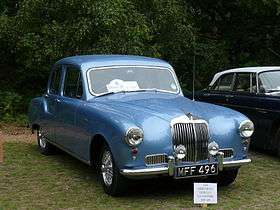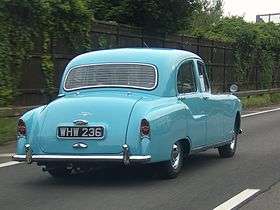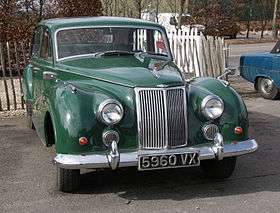Armstrong Siddeley Sapphire (motor car)
The Armstrong Siddeley Sapphire is a large automobile which was produced by the British company, Armstrong Siddeley Motors Limited, from 1952 to 1960.
| Armstrong Siddeley Sapphire | |
|---|---|
.jpg) Sphinx symbol of silence | |
| Overview | |
| Manufacturer | Armstrong Siddeley Motors Limited |
| Production | 1952–1960 3½ litre 7,697 4 litre 981 2¼ litre 1,406 Total 10,084 built[1] |
| Body and chassis | |
| Class | executive |
| Chronology | |
| Successor | none |
A distinctive element of the Sapphires was the traditional Armstrong Siddeley V-shaped radiator grille with the Sphinx motif mounted on it.
On some models the sphinx sported aircraft wings carrying tiny Armstrong Siddeley Sapphire jet engines.
Sapphire 234
| Sapphire 234 | |
|---|---|
 Sapphire 234 sports saloon registered 1958 | |
| Overview | |
| Production | 1955–1958 803 made[1] |
| Body and chassis | |
| Body style | 4-door saloon |
| Layout | Front-engine, rear-wheel drive |
| Related | Sapphire 236 |
| Powertrain | |
| Engine | 2,290 cc Straight-4 |
| Transmission | Manual with optional overdrive |
| Dimensions | |
| Wheelbase | 111 inches (2,819 mm)[2] |
| Length | 180 inches (4,572 mm) |
| Width | 68.5 inches (1,734 mm) |
The Sapphire 234 and 236 were two cars identical in appearance but sold with different engines having different performance characteristics. The 234 could be purchased with wire wheels as an optional extra.
The 234 was produced from 1955 to 1958 and used a four-cylinder 2,290 cc version of the 346 engine.[3] The transmission was a manual four-speed gearbox with optional overdrive.[3]
A 100 mph car intended for the man who liked high performance.[4]
803 were produced.[3]
| Sapphire 234 engine | |
|---|---|
| Overview | |
| Manufacturer | Armstrong Siddeley Motors Limited |
| Layout | |
| Configuration | 4-cylinder in-line |
| Displacement | 2,290 cubic centimetres (140 cu in) |
| Cylinder bore | 90 mm (3.5 in) |
| Piston stroke | 90 mm (3.5 in) |
| Valvetrain | OHV |
| Compression ratio | 7.5:1 |
| Combustion | |
| Fuel system | Twin S.U. carburetters |
| Fuel type | Petrol |
| Cooling system | Water |
| Output | |
| Power output | 120 bhp (89 kW; 120 PS)[5] |
Sapphire 236
| Sapphire 236 | |
|---|---|
 Sapphire 236 saloon registered March 1956 | |
| Overview | |
| Production | 1955–1957 603 made[1] |
| Body and chassis | |
| Body style | 4-door saloon |
| Layout | Front-engine, rear-wheel drive |
| Related | Sapphire 234 |
| Powertrain | |
| Engine | 2,309 cc Straight-6 |
| Transmission | Manumatic or Manual either with optional overdrive |
| Dimensions | |
| Wheelbase | 111 inches (2,819 mm)[2] |
| Length | 180 inches (4,572 mm) |
| Width | 68.5 inches (1,734 mm) |
| Chronology | |
| Predecessor | Whitley |
The 236 was made between 1955 and 1957 and used the six-cylinder 2,310 cc engine previously seen in the Armstrong Siddeley Whitley. A conventional manual gearbox was available but many were fitted with a Lockheed Manumatic "clutchless" transmission. Overdrive was an option on either transmission.
This car with an 85 mph maximum was intended to be a quiet, flexible, easy-to-drive saloon.[4]
603 were produced.[3]
| Sapphire 236 engine | |
|---|---|
| Overview | |
| Manufacturer | Armstrong Siddeley Motors Limited |
| Layout | |
| Configuration | 6-cylinder in-line |
| Displacement | 2,309 cubic centimetres (141 cu in) |
| Cylinder bore | 70 mm (2.8 in) |
| Piston stroke | 100 mm (3.9 in) |
| Valvetrain | pushrod OHV |
| Compression ratio | 7.5:1 |
| Combustion | |
| Fuel system | Single downdraught Stromberg carburetter |
| Fuel type | Petrol |
| Cooling system | Water |
| Output | |
| Power output | 85 bhp (63 kW; 86 PS)[5] @4500 rpm |
Sapphire 346
| Sapphire 346 | |
|---|---|
| Overview | |
| Production | 1953–1958 7,697 made[1] |
| Body and chassis | |
| Body style | 4-door saloon limousine |
| Layout | Front-engine, rear-wheel drive |
| Powertrain | |
| Engine | 3,435 cc Straight-6 |
| Dimensions | |
| Wheelbase | 114 in (2,896 mm)[2] 133 inches (3,378 mm) (limousine) |
| Length | 193 in (4,902 mm)[6] 212 in (5,385 mm) (limousine) |
| Width | 72 in (1,829 mm)[6] |
| Height | 63 in (1,600 mm)[6] |
The 346 was the first of the Sapphires introduced late in 1952 for sale in 1953 and continuing until 1958. The six-cylinder 3,435 cc engine had hemi-spherical combustion chambers and could have optional twin Stromberg carburettors(£25 extra)[6] which increased the output from 125 to 150 bhp (93 to 112 kW) giving a top speed in excess of 100 mph (161 km/h). The front suspension was independent coil springs with a rigid axle and leaf springs at the rear. The Girling hydraulic brakes used 11 in (279 mm) drums all round.[6]
The body was available as a four- or six-light (two or three windows on each side) at the same cost and with either a bench or individual front seats. The seats were finished in leather, with the dashboard and door-cappings in walnut veneer. A heater was standard.
It was introduced with the choice of a Wilson electrically-controlled finger-tip four-speed pre-selector gearbox as a £30 option,[6] or four-speed synchromesh gearbox. It became available with automatic transmission (Rolls Royce four-speed) with the introduction of the Mark II in 1954.
A long-wheelbase model was launched in 1955 as a limousine version which had the pre-selector gearbox as standard, however, there was an optional four-speed manual column-change gearbox available. It featured a longer wheelbase (extended by 21 inches or 535 mm) chassis with a body incorporating a limousine division.
Models for export to the U.S. were always delivered with twin carburettors.[7]
A saloon with the optional twin-carburettors and synchromesh transmission tested by the British magazine The Motor in 1953 had a top speed of 100.1 mph (161.1 km/h) and could accelerate from 0–60 mph (97 km/h) in 13.0 seconds. A fuel consumption of 18.7 miles per imperial gallon (15.1 L/100 km; 15.6 mpg‑US) was recorded. The test car cost £1,757 including taxes.[6]
7,697 were produced.
Star Sapphire
| Star Sapphire | |
|---|---|
 | |
| Overview | |
| Manufacturer | Armstrong Siddeley Motors Limited at Bristol Siddeley Engines Limited, Coventry[8] |
| Production | 1958–1960 980 made[1] |
| Body and chassis | |
| Body style | 4-door saloon limousine |
| Layout | Front-engine, rear-wheel drive |
| Powertrain | |
| Engine | 3,990 cc Straight-6 |
| Dimensions | |
| Wheelbase | 114 inches (2,896 mm)[2] 135 inches (3,429 mm) (limousine) |
| Length | 194 inches (4,928 mm) 212 inches (5,385 mm) (limousine) |
| Width | 74 inches (1,880 mm) |
| Height | 63.5 in (1,613 mm)[9] |
The Star Sapphire saloon was announced on 17 October 1958[10] and production continued through to the summer of 1960.[8] It retained the previous model's commanding driving position. Though little changed externally, the radiator grille no longer rose to the top of the bonnet, many refinements were incorporated.
The six-cylinder engine was enlarged more than 16% to 3,990 cc with larger twin Stromberg carburettors as standard and power output increased to [SAE] 165 bhp (167 hp, 123 kW), or [DIN] 145 bhp (147 hp, 108 kW). Perhaps more important was an increase of nearly 30% in torque at 50 m.p.h. Big end and main bearings were now made of lead indium and a vibration damper fitted to the nose of the crankshaft. The compression ratio was raised to 7.5 to 1. The car could now lap the Lindley high speed track at 104 m.p.h.[10]
.jpg)
Various suspension modifications had been carried out. Servo-assisted 12 in (305 mm) Girling disc brakes were now installed on the front wheels and Burman recirculating ball power steering was standardised with a turning circle reduced by 4'6". A BorgWarner type DG automatic gearbox was fitted which incorporated a lever on the facia to hold intermediate gear at 35, 45, 55, and 65 m.p.h.[10]
Door hinges were now concealed and the front doors now hinged at their leading edge. There was an independent heater for the rear passengers and demisting slots for the rear window. All features were standard, the provision of alternatives being believed to lead to an unsatisfactory compromise.[10]
902 saloons were produced, as well as 77 long-wheelbase cars,[3] 73 of which were built as limousines (including 2 prototypes). The limousine version was made in 1960 only and had a single-carburettor engine and manual gearbox (the automatic gearbox was fitted to 12 examples). The remaining 4 chassis were used for 3 hearses and an ambulance. 980 Star Sapphires were produced.
The Star Sapphire won the £4,000 four-door coachwork class at the 1958 Earls Court Motor Show ahead of a Princess limousine and a Jaguar Mark IX.[11]
A Star Sapphire saloon with automatic transmission was tested by the British magazine The Motor in 1959. It had a top speed of 99.6 mph (160.3 km/h) and could accelerate from 0–60 mph (97 km/h) in 14.8 seconds. A fuel consumption of 15.4 miles per imperial gallon (18.3 L/100 km; 12.8 mpg‑US) was recorded. The test car cost £2,498 including taxes of £735.[9] By then purchase tax had been reduced by one-sixth on 8 April 1959.
Market sector
Prices including tax October 1958
- £2,646 Star Sapphire
- £2,492 Daimler Majestic
- £2,163 Jaguar Mark IX with automatic transmission
- £1,939 Jaguar XK150
- £1,666 Humber Super Snipe with automatic transmission
Star Sapphire Mk. II
| Star Sapphire MkII | |
|---|---|
| Overview | |
| Production | 1960 1 made[1] |
| Powertrain | |
| Engine | 3,990 cc Straight-6 |
The Mk II version did not get beyond prototype stage in 1960 and only one was produced.
In Film and Books
- Diamonds Are Forever by Ian Fleming
- In chapter 6, 'In Transit', James Bond gets picked up at the Ritz Hotel in London by a chauffeur-driven black Armstrong Siddeley Sapphire. The year and mark of the car are not noted but the novel was published in 1956. The car has red dealer plates.
- 1956 British film Wicked as They Come
- Kathy Allen, played by Arlene Dahl is picked at the London Airport and dropped of at The May Fair Hotel in a black Armstrong Siddeley Limousine.[12]
References
- Sedgwick, M.; Gillies, M. (1986). A-Z of Cars 1945-1970. Devon, UK: Bay View Books. ISBN 1-870979-39-7.
- Culshaw; Horrobin (1974). Complete Catalogue of British Cars. London: Macmillan. ISBN 0-333-16689-2.
- Robson, Graham (2006). A to Z British Cars 1945-1980. England: Herridge & Sons. pp. 32. ISBN 0954106393.
- Britain's New Cars On Show At Earls Court. FROM OUR MOTORING CORRESPONDENT. The Times, Oct 18, 1955; pg. 11; Issue 53354.
- ARMSTRONG-SIDDELEY EXTEND SAPPHIRE RANGE: Two New Cars in Specialist Class. A Motoring Correspondent. The Manchester Guardian (1901-1959) [Manchester (UK)] 18 Oct 1955: 2.
- "The Armstrong Siddeley Sapphire". The Motor. October 7, 1953.
- Robert Penn Bradly: The Original 346 Sapphire explored to great depth; Limula Pty Ltd, Bardwell Park, NSW, Australia, 2008.
- Coventry Dispute Cuts Production. The Times, Monday, Feb 08, 1960; pg. 5; Issue 54689
- "The Armstrong Siddeley Star Sapphire". The Motor. June 10, 1959.
- New Armstrong Siddeley Car. The Times, Friday, Oct 17, 1958; pg. 4; Issue 54284.
- Car Coachwork Competitions.The Times, Friday, Oct 31, 1958; pg. 14; Issue 54296.
- Long wheelbase Sapphire limo has Arlene Dahl as passenger (at 3:05)
External links
- Armstrong Siddeley Sphinx motif
- retrospective history, focusing on early Sapphire engines
- A-Z of Cars 1945–1970. Bay View Books 1986. Michael Sedgwick and Mark Gillies. ISBN 1-870979-39-7